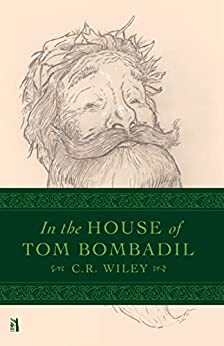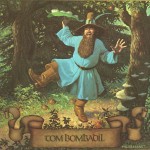Hamilton, Ontario, Canada. Who is Tom Bombadil? Readers of J.R.R. Tolkien’s masterpiece, The Lord of the Rings, have been asking this question ever since the epic tome first appeared in print in 1954. Novice fans of the book as well as diehard veterans of Tolkien’s Legendarium are equally perplexed by this mysterious character. In their quest for answers, many have scrutinized every jot and tittle from Tolkien’s pen, but the esteemed author never reveals in the novel, in his letters, or in his other writings exactly who Tom is. Those who have only viewed Peter Jackson’s film trilogy (2001–2003) also wonder who this bewildering fellow is, since the director opted to exclude Bombadil from his big screen adaptation altogether. Jackson has stated the reason he cut Bombadil was because he felt that the character wasn’t essential to the basic plot of the story. Some readers of The Lord of the Rings agree – not only do they ask, “Who is Tom Bombadil?” but they also ask “Why is he there?”
C. R. Wiley, in his accessible yet perceptive little book In the House of Tom Bombadil, argues that we need to change the way we approach the “who?” and “why?” of Tom Bombadil. Wiley suggests we need to grapple with the question, not as a modern scientist or as a Sherlock-like sleuth, but as a philologist steeped in medieval lore. This makes good sense given that Tolkien was a philologist and professor of Anglo-Saxon and Medieval English at Oxford University. His understanding and appreciation for languages and for the legends that grew from them helped shape every aspect of Tolkien’s Middle-earth mythology. If we are going to really understand Tom Bombadil, we must see him as an outworking of both Tolkien’s love of language and lore.
A quest for answers
Tackling the question of Bombadil’s identity and his role in the novel seems as insurmountable a task as a lowly hobbit saving Middle-earth from Sauron. But with hobbit-like humility and a dash of Tookish boldness, author C.R. Wiley sets out to answer the baffling questions surrounding Tom Bombadil. Wiley has no pretentions of being an expert on Tolkien; there are highly qualified and highly esteemed authorities on Tolkien’s Legendarium, even a growing number within academia. But the debate on the identity of Bombadil rages inconclusively among experts in ivory towers just as often as on social media platforms among amateurs.
What Wiley brings to the discussion about Tom Bombadil is his honest and relatable quest to uncover the function that he plays in Tolkien’s Middle-earth masterpiece. Wiley is, however, no mere dabbler in Tolkien’s Legendarium. In fact, he is steeped in the works of Tolkien, as demonstrated by his effortless citing of The Lord of the Rings alongside Tolkien’s other, lesser known and (certainly) lesser read works, such as The Silmarillion, The History of Middle-earth, and Leaf by Niggle. Wiley is also steeped in the works of C.S. Lewis and G.K. Chesterton – writers and thinkers who helped to influence and shape Tolkien’s own writing and thinking.
But perhaps the most valuable aspect of Wiley’s approach is his background as a pastor and preacher. Like a faithful minister of the Word of God, he is vigilant in handling the text as it is, on the page; he is careful about contextualizing and cross-referencing words, phrases, and concepts within Tolkien’s broader works. He also avoids reading too much into the text. This is helpful, since Tolkien was fastidious with his work, striving for accuracy and consistency across all of his writing, even works that were not published until years after his death. Tolkien was also committed to telling a good story in the best way possible. This is why Wiley, throughout his book, handles the paradoxes and tensions of Tolkien’s text not as inconsistencies to be brushed aside, but rather as brushstrokes of a master artist at work.
For such a meticulous and calculated author, an author who spent decades crafting his mythology, why would Tolkien permit such a cloud of mystery to surround this unforgettable and prominent character? Wiley helps us see that the mystery is no mistake: Tolkien intentionally made Tom Bombadil an “enigma.” Like Peter Jackson, Tolkien also asserts that Bombadil is not important “to the narrative”; but then he adds that “he represents something that I feel important, though I would not be prepared to analyze the feeling precisely. I would not, however, have left him in, if he did not have some kind of function.” Though not important to the plot, Bombadil possesses, according to Tolkien, an important function in the text.
A different way of knowing
Fans of Tolkien’s works, acting like detectives in search of the “one-answer-to-rule-them-all,” often insist on allegorical and symbolic interpretations of various events, objects, and characters in The Lord of the Rings. In their investigation to uncover hidden meanings, some have suggested that the Ring of Power represents the Atomic bomb, the Eagles represent the Americans entering World War II, Saruman’s deforestation and mechanization at Isengard represent industrialization of turn-of-the-century Britain, Saruman and Sauron symbolize the rise of fascist dictatorships, and so on. Tolkien eschewed this sort of allegorizing of his writing, as he adamantly declares in the foreword to the second edition of The Lord of the Rings. He writes, “As for any inner meaning or ‘message’, it has in the intention of the author none. It is neither allegorical nor topical.” The fact that the sort of evil Sauron displays in Middle-earth can also be seen in the activities of Nazis and Fascists in history does not mean that Tolkien is intentionally allegorizing these political ideologies. The applicability of Sauron’s evil to contemporary human evil simply underscores the veracity of Tolkien’s portrayal of a fallen world. As a Christian, Tolkien believed that the fall of humanity told in Genesis 3 opened the door to evil in the universe – and this is the same evil that motivates both the “Hitlers” of history as well the “Saurons” of Middle-earth.
Despite Tolkien’s warnings against allegorizing his work, theories abound on the mystery of Bombadil: a cursory search online will reveal people arguing that Bombadil represents Ilúvatar, the Creator of Middle-earth, or one of the angelic figures called Maiar, or the pre-incarnate Christ, or even Tolkien himself – the author, entering the stage of his own play. Wiley deftly addresses these propositions, exposing limitations and evidence against each one.
He then draws us into a new way of thinking about “mystery” in general. Wiley observes that a “mystery is not a problem; it is a hidden truth,” one that isn’t simply solved but rather experienced and discovered. We won’t discover hidden truth through dissection or through scrutinizing facts under a microscope. That is akin to cutting “open a ball in search of bounce,” as writer Roger Lancelyn Green once remarked about those who seek to scrutinize Tolkien’s work. Destroying a ball in search of bounce is an apt description for the doomed-to-fail approach to understanding the meaning of the characters and events of Middle-earth. By dissecting Bombadil to see what makes him tick ultimately results in neutralizing the intended function of the subject in question. As the old adage goes, the “whole” is often greater than the sum of its parts. C.S. Lewis makes a similar observation about stars in his fifth Narnia book, The Voyage of the Dawn Treader. Upon encountering a “retired star” in bodily form, one of the characters declares, “In our world, a star is a huge ball of flaming gas.” The star astutely replies, “Even in your world, my son, that is not what a star is but only what it is made of…”
Who is Tom Bombadil?
What Lewis and Tolkien (and Wiley) are encouraging us to do is to see things in a different way; for example, we need to see love not merely as chemical reactions, or beauty and truth not merely as social constructs, or goodness not merely a pragmatic means of survival. Wiley points out that pursuing knowledge by “cutting open of bouncing balls” is exactly what Saruman does in his relentless study of the dark arts and scrutinizing the evils of Sauron, a study that ultimately corrupts him. This is underscored by Gandalf, who chastises Saruman’s behaviour by declaring that the man who “breaks a thing to find out what it is has left the path of wisdom.”
Wiley reminds us that we mustn’t lose sight of the forest because of the trees. The fact that some aspects of Tolkien’s portrayal of Bombadil align with allusions to Christ cause some readers to conclude that he must be a pre-incarnate Christ breaking into Middle-earth. There is some compelling evidence to suggest this. For example, when Frodo first meets Bombadil, he marvels at the way he wields incredible authority over Middle-earth, and he wonders aloud who he could be. The answer Frodo receives is “He is,” which is as cryptic as it is provocative. Such a response reminds us of God’s self-declared name, “I Am That I Am” (Exodus 3:7–8, 13–14). C.R. Wiley leads his readers towards understanding the function of Bombadil within the larger story, not as an agent of the plot or a one-to-one stand-in for another person or character, but more as a reminder of deeper truths that will shape how readers approach the events and characters of the novel.
What we know about Bombadil is that he is a powerful and ancient being, older than Gandalf and older than the elves, and he has no interest in “trinkets” that are used to dominate others. Although he is aware of evil, he has no fear of it. Instead, he travels about his business bedecked with yellow boots, a blue coat, and a feathered cap. He wanders the woods singing silly songs of seemingly nonsense verse and he possesses an indomitable cheerfulness. In a story filled with perilous journeys, evil rings, and the terrors of trolls, orcs, and wraiths, it would seem that Bombadil’s jolly demeanor is out of place. But, when the hobbits first encounter him in the Old Forest, his arrival is as welcome to the reader as it is to the hobbits. This is because Tom rescues Frodo and his companions from certain death – not once, but twice in the two chapters in which he appears. His appearance is unexpected yet timely; what could have been a tragic ending – the death of the hobbits and the failure of the quest – is not only avoided but happily and joyfully thwarted by Tom Bombadil. In other words, when the story is on the brink of a catastrophe, Tolkien suddenly introduces a “eucatastrophe”; that is, a sudden and good turn of events. Tolkien coined this neologism by combining the Greek prefix ευ- meaning “good” with καταστροφή, meaning “sudden turn.”
In his essay, “On Fairy-stories,” Tolkien describes this “good catastrophe” as
a sudden and miraculous grace: never to be counted on to recur. It does not deny the existence of dyscatastrophe, of sorrow and failure: the possibility of these is necessary to the joy of deliverance; it denies (in the face of much evidence, if you will) universal final defeat and in so far is evangelium, giving a fleeting glimpse of Joy, Joy beyond the walls of the world, poignant as grief.
The “Joy beyond the walls of the world” that Tolkien describes here is the gospel of Christ, which Tolkien asserts “is the greatest and most complete eucatastrophe.” It is no mere fantasy, for “this story has entered History and the primary world; the desire and aspiration of sub-creation has been raised to fulfillment of Creation.” He goes on to say,
The Birth of Christ is the eucatastrophe of Man’s history. The Resurrection is the eucatastrophe of the story of the Incarnation. This story begins and ends in joy. It has pre-eminently the ‘inner consistency of reality’. There is no tale ever told that men would rather find was true, and none which so many sceptical men have accepted as true on its own merits.
Bridging Tolkien’s idea of eucatastrophe in The Lord of the Rings with the gospel account is a key stepping stone to understanding the “who” and “why” of Tom Bombadil. Wiley notes that Bombadil’s first eucatastrophe is when he rescues the hobbits from a “tree” that is trying to kill them; the second eucatastrophe is when he rescues the hobbits from a “grave” that is trying to entomb them. To a super-sleuth, this is further evidence of Bombadil specifically representing Christ, the one who died on a tree and rose up from the grave. But Tolkien doesn’t intend the Willow tree to represent the cross nor the tomb of the Barrow-downs to represent the grave of the crucified Christ. Bombadil does not represent Christ, but he does reflect Tolkien’s Christian worldview that good will ultimately triumph over evil. Tolkien believed that life – in fantasy as well as history – is filled with hardships and setbacks. Christians endure suffering in this life, he argued, because of their hope in the final victory of Christ alone. Tolkien’s eschatological view is that there will be a final eucatastrophe at the end of history, where all will be made right. Tolkien also adds that along the way – in the midst of hardship and difficulty – life will contain “(and in a legend may contain more clearly and movingly) some samples or glimpses of final victory.”
The “one-answer-to-rule-them-all”
So who exactly is Tom Bombadil? Wiley offers readers some concluding thoughts in his book about who Tom is and why he is in the book. However, grappling with the mystery is perhaps more important than solving it. Readers of In the House of Tom Bombadil must travel that road themselves if they are going to truly understand, believe, and embrace the destination that Wiley is leading them to discover. As Wiley remarks, “People don’t have everything that they need before beginning a perilous quest. They must learn on the job.” In this short review, I’ve given you a foretaste of a rich and rewarding banquet Wiley has prepared; I encourage you to pull up a chair In the House of Tom Bombadil, and partake of the feast for yourself.





6 comments
Jeremy Johnston
I think you are on to something. Bombadil is certainly “like” the Green Man, or at least, similar to what the Green Man represents at a prototypical level. His bearded, jolly demeanor along with his affinity with nature draws strong parallels to Tolkien’s Tom. For Tolkien, however, his characters are never a one-to-one comparison to another character, but rather a hint, echo, and expectation of “once was” and “will again be.” Another way to think of it is “applicability” versus allegorical representation. Thanks for commenting!
Leslie
I have always thought, since first reading aged 11 or so, that Bombadil is the Green Man or Herne the Hunter. A force of green energy, disinterested in the affairs of anyone else.
Gunnar Thorstenson
Lovely thoughts, sounds like a great read. I would hope the book also discusses how Tom represents Tolkien’s love of the earth. In a 1937 letter Tolkien calls Tom Bombadil as “the spirit of the (vanishing) Oxford and Berkshire countryside”. That seems an important description. One can see how closely Tom is associated with his land, yet never takes ownership of it. When Frodo asks Goldberry if the land belongs to him, she replies: “‘The trees and the grasses and all things growing or living in the land belong each to themselves. Tom Bombadil is the Master.” One can see a beautiful example of stewarding the earth in Tom Bombadil, a theme that comes up again and again through the book. From the Shire to the white tree of Gondor, the very land is a character, something I’ve always loved about Tolkien’s work. I think our world full of Ted Sandymans could use a few more Toms or Sams.
Jeremy Johnston
Hey Gunnar,
You are right that environment issues was of great importance to Tolkien. It shows up in almost all of his writing. Wiley does address some of the environmental aspects of Bombadil, especially in discussing the differences between “dominion” and “domination.” Bombadil exercises dominion over nature. There is a difference! Thanks for your comments!
Kim Gibson
An enticing review. I totally agree with the premise of the book, and love the challenge. I feel it cannot be solved, this enigma, but the journey to know Tom is the important thing.
Jeremy W. Johnston
Thanks for reading and for your comment! You are right that the mystery of Bombadil is beyond a definitive solution. He is really a “hint” and “foreshadow” of more to come, so as an enigmatic character, he encourages us to keep searching, keep wondering, and keep hoping.
Comments are closed.